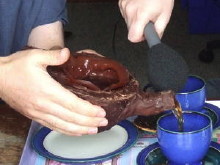Chocolate Teapots
Back in 2001, Simon Bradshaw and his colleagues published a tongue-in-cheek article in Plotka analyzing the utility of a chocolate teapot. They were inspired by the phrase (common in the UK) that something is as "useful as a chocolate teapot." Their conclusion was that chocolate teapots are indeed not very useful since they leak everywhere, and therefore they "serve as an excellent baseline of uselessness against which to compare other, similarly dysfunctional, items."
The article became a minor classic of scientific humor. (Yeah, science humor tends to be a bit nerdy) and was replicated by other researchers.
 More recently, the Naked Scientists (authors of Crisp Packet Fireworks) decided that the problem was that the teapot was too thin. If you make the chocolate thick enough, it'll hold the hot water and brew tea. But how thick? Two centimeters proved to be enough. They note:
More recently, the Naked Scientists (authors of Crisp Packet Fireworks) decided that the problem was that the teapot was too thin. If you make the chocolate thick enough, it'll hold the hot water and brew tea. But how thick? Two centimeters proved to be enough. They note:
The main structural design defects were the lid, which melted, and the spout, which collapsed after the tea was poured.
The article became a minor classic of scientific humor. (Yeah, science humor tends to be a bit nerdy) and was replicated by other researchers.

When chocolate melts it doesn't become totally liquid immediately, it remains quite viscous. Unless you apply a fairly large force to the melted chocolate, it seems to sit there. Chocolate is also mostly made of fat, which is a good thermal insulator (whales use blubber as a form of insulation). This means that the molten chocolate near the hot water protects the less molten chocolate below it, insulating it from the heat of the water. Also, it takes a significant amount of energy to melt chocolate, so it will take a significant amount of time to move heat into the solid chocolate, thus slowing its melting.
The main structural design defects were the lid, which melted, and the spout, which collapsed after the tea was poured.
Comments
Hmm. The Crisp Packet Fireworks link works for me, but all links to Amazon we run as affiliate links. So if you happen to follow the link and buy anything at Amazon we get a penny or two. But if you're using ad blocker software, the ad blocker might disable the link.
Posted by Alex on 09/04/08 at 12:03 AM
Commenting is not available in this channel entry.

Category: Food | Science